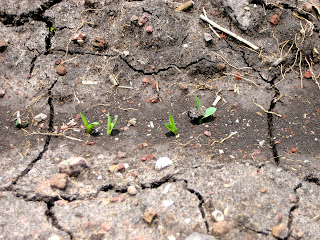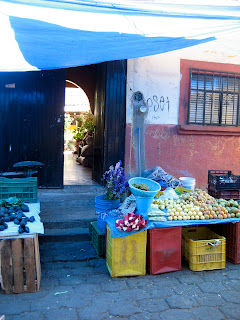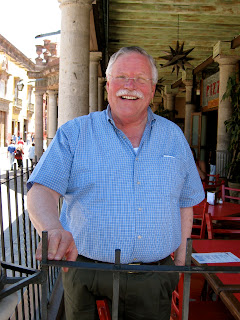The other day we were in a large music store that sells instruments and music equipment, and the clerk politely listened to Chon describing how we had just arrived from Mexico, and then listened more while he described what we would be doing a few hours later, until the clerk’s eyes suddenly lit up in comprehension, and he exclaimed in astonishment, “Oh - then you are actually Working Musicians!”
Yes, we are. And last night, the third night of a ten-night gig, was one of those nights when things went right for us against the odds, with some magical moments from the other elements of the show, and some surprisingly cursed performances from others.
“We are Galileo, and we will be your musical hosts for the evening.”
 |
| Audience participation can be stunning! |
This gig is a dinner show, and sometimes the results depend on the audience. Well, OK, the audience ALWAYS plays a big part. Aloof teenagers, timorous children, angry adults with obvious issues - that’s just a fragment of the population, and the holiday season seems to aggravate the best and the worst in each person. Last night the audience numbered eighteen, instead of an average of three hundred. So we made adjustments to our schedule and started late on purpose, since we didn’t have many people to handle. We played dance numbers, and sung seasonal songs for about a half hour, all the while noticing that not a single member of the dance troupe, normally numbering ten or twelve, had stopped by to wave hello. However, as our last “cue” song was happening, I could see the great feathered headdresses of the dancers approaching.
We are the MC's for the show, and I introduced the dancers with a great deal of energy, and they headed to the stage, which in this case is the dance floor, at a slightly lower level than the stage where we are situated. Chon busied himself with the audio equipment, enigineering changes to the sound as I watched three dancers prepare to dance. Normally there are six to eight dancers.
The first set of dances is “Aztec Ceremonial Dances”, and of the FOUR dancers present, one played (blew) the conch shell. He was not in costume, and remained out of sight. One dancer, arguably the best, had been elected to play a very large (bigger and taller than a child) drum. The two other dancers were the couple who is the moving force of the dance troupe, an experienced middle-aged couple. Are you counting? Two dancers instead of six or eight. The woman is charming and talented. Her husband is rather tongue-tied and shy, and, well, just not a "born" dancer. That is to say, he dances. In a professional dance troupe. With a lesser sense of rhythm, the movements and steps of the Mexican dances are extremely challenging and intricate. But our dancer bravely rose to the challenge
I was watching, amused, to see what would come of this extremely diminished dance group, when Chon glanced up from what he was doing, and with a dreadful scowl, his eyebrows shot up in shock as he saw the dancers. The woman encouraged her partner through the steps of the various dances, until the final presentation, the Fire Dance, when a single dancer (and not usually THIS man!) dances around a burning flame in a stone mortar, at times bringing his feet and legs extremely close to the flame, and for the finale, holding the burning flames high above his head, moving them from hand to hand, then returning the flames to the mortar, and eventually extinguishing them with a bare foot. This he did, valiantly struggling along, until he dropped the flame on the floor, quickly recovered it and returned it to the mortar, and then it just, sort of, went out. And that was the finale of the dance. The beautiful, lithe, slender dancer who was beating the rhythm on the drum, also just - stopped. What else?
We quickly began to applaud, and the audience joined us entusiastically. Yay!
Later in the show, the dance group, scheduled to present a group of regional dances from Mexico, returned, this time with the conch player (to us, the New Guy). So there were the four of them on the dance floor. For some technical reason they chose to use a slower, training recording of one of the extremely fast whirling polkas from northern Mexico, and the “new guy” to us, the one who had blown the conch shell, just danced the polka at the speed he was accustomed to - that is, at a much faster speed. His partner did not - she valiantly attempted to dance to the tempo of the recording, and to assist her partner to hold back, as well. The steps were right. They just couldn’t really dance it together...
And as for US, well, one of our speakers was blown, and we could not replace it. So Chon used a monitor (a speaker that performers use to hear themselves in the all the amplified sound swirling about),in place of the broken speaker, which made the bass sound normal. I play a bass part for all the songs we perform, with my left hand, on a keyboard. The sound is a “real” bass sound, that I normally like. The night before, it came out of the speaker as a cross between an extremely loud belch and a rattle. At first, hesitant to produce such a sound, I played rather gingerly, but as the night wore on, I became more accustomed to it, and realizing that the audience probably really wasn’t noticing, gave it more energy and volume. Using the monitor was a relief because the sound was good - normal, but accompanied by the worry of the possibility of blowing another speaker.
The world-famous Bob Baker Marionettes are part of the show, as well, and do a twenty-minute set. They are charming, OLD puppets, with fading feathers, maribou, felt hats, and chiffon, and the puppet-master is young and very, very good. He can make a marionette look like it’s tap-dancing. Or doing a provocative (not TOO provocative - it’s a family show!) Santa Baby routine. Or juggle. Or fly.
Normally, there are twenty or thirty children sitting on the dance floor to see the puppets. Last night? There was one. He was about eight years old. His little sister, maybe five years old, was terrified, and spent most of the presentation tearfully huddled in her father’s arms at a nearby table. Soooo, I went to sit with the boy to get a great view of the routine. Then several other adults decided to join us, too, so there were six of us. Having been charmed by Bob Baker's marionettes as a spell-bound child seeing Hansel and Gretel, I am a serious FAN of the marionette show, and the set was wonderful. All of us were laughing and nudging each other at clever details. I hadn’t known that the big pink cat does funny things with her handkerchief! My face was aching from smiling so much. The lone boy was a perfect audience member as well, and was charmed and thrilled by the up-close-and-personal marionettes.
And later on, when we had a traditional-styled posadas procession around the area, the adults took part, as well, in the part of the show usually done by youngsters. And the piñata, you ask? Waiters and waitresses joined in, as well as the paying audience.
I had a wonderful time. And as I chatted with the audience after the show, I could tell they did, too.






















































